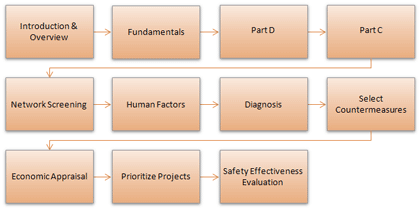Introduction
This section provides a review of current training opportunities offered by the Federal Highway Administration’s (FHWA) Resource Center, the National Highway Institute (NHI), Institute of Transportation Engineers (ITE), and American Association of State Highway Transportation Officials (AASHTO). Unless otherwise indicated these sessions are instructor-led. In some cases, the review also included an assessment of ongoing or nearly completed projects including the NCHRP 17-38 Highway Safety Manual Course and the FHWA Highway Safety Improvement Program (HSIP) Course. Since the NCHRP 17-38 course is intended to be adaptable to various audiences, the modules of the NCHRP 17-38 training are presented as individual modules in the matrix.
The FHWA Resource Center
The FHWA Resource Center is a key partner in supporting the education and training of staff FHWA Division offices, state Departments of Transportation, Metropolitan Planning Organizations, local agencies in the Highway Safety Manual. Resource Center staff also provides expert assistance to these agencies.
The National Highway Institute
The National Highway Institute is a division of the FHWA. The main purpose of NHI is to provide training that drives improvement of the performance of the transportation industry.
NCHRP 17-38 Overview Training Materials for the Highway Safety Manual
NCHRP 17-38 was initiated to specifically develop overview training for the Highway Safety Manual. Once completed, the training materials (instructor and participant materials) will be available on-line through the Transportation Research Board, for use and customization by agencies, organizations and individuals. The training materials will include an example training program, an instructor guide, a comprehensive participant notebook, and Microsoft PowerPoint presentations with instructor notes. The training includes examples across each of the different chapters and parts of the HSM.
HSM and Related Training Opportunities
Exhibit 1 summarizes the HSM training opportunities as of May 2011. The training matrix presented in Exhibit 1 categorizes courses and modules by the topic and level of training with the understanding that some overlap may exist across the various parts of the HSM.
The levels of training shown in Exhibit 1 are NHI training levels: basic, intermediate, and accomplished.
At the basic level, the training can be summarized as:
- No matter what your background, this course or training event provides an overview of the subject matter.
- No pre-requisites apply to this training.
- The training event is a good opportunity for career development, cross-training or developing a new competency.
At the intermediate level, the training can be summarized as:
- Participants need to have a basic understanding of the subject matter prior to attending this level of course or training event. Some practical knowledge or previous training in the subject is needed.
- Participants that use this subject knowledge or apply it on a regular basis as a specialist, manager, or supervisor are best suited to take this training.
- The subject matter may provide a deeper knowledge to participants for something that is similar to what they are already doing, but may be a new technology or regulation that need to be incorporated into what they are already doing.
At the accomplished level, the training can be summarized as:
- Participants need to have a good understanding of the subject matter prior to attending this level of course or training event. Either deep practical/applied knowledge and skills or previous extensive training in the subject matter is needed.
- Participants that use this subject knowledge and have a demonstrated mastery of the subject as a specialist, manager or supervisor are best suited to take this training.
- The subject matter may provide a greater depth of deeper knowledge, understanding and ability to apply the knowledge and judgment to problems where solutions are not always directly applicable. Participants may also need to incorporate new technology in what they are already doing.
Note that many of the FHWA HSM webinar series were grouped into Part C (predictive method) even though the webinars also included Part D content on CMFs.
| HSM Topic Area | Level of Training (Level as defined by the NHI course level definition) | ||
|---|---|---|---|
| Basic | Intermediate | Accomplished | |
| Part A Introduction, Human Factors, Fundamentals |
Introduction Module (NCHRP 17-38) Human Factors Module (NCHRP 17-38) Fundamentals Module (NCHRP 17-38) Introductory Webinar hosted by AASHTO, FHWA, and TRB HSM Introduction & Overview (FHWA Resource Center Webinar) |
||
|
Part B |
Highway Safety Improvement Program Manual (NHI – 380103) Part B Overview Module (NCHRP 17-38) |
HSM Practitioner’s Guide for Horizontal Curves (NHI – 380088) Project Identification Using the HSM (FHWA Resource Center Webinar) HSM Applications to HSIP (FHWA Resource Center Webinar) Network Screening Module (NCHRP 17-38) Diagnosis and Countermeasure Selection Module (NCHRP 17-38) Economic Appraisal and Prioritization Module (NCHRP 17-38) Safety Effectiveness Evaluation Module (NCHRP 17-38) |
New Approaches to Highway Safety Analysis (NHI – 380075) Low-Cost Safety Improvements Workshop (NHI – 380076) Intersection Safety Workshop (NHI – 380077) Using SafetyAnalyst (AASHTOWare) Empirical Bayes Analysis for Safety (FHWA Resource Center) HSIP Project Identification (FHWA under development) HSIP Project Evaluation (FHWA under development) |
| Part C Predictive Methods |
HSM Applications to Two-Lane Rural Roads (FHWA Resource Center Webinar) HSM Applications to Urban/Suburban Intersections (FHWA Resource Center Webinar) HSM Applications to Rural Intersections (FHWA Resource Center Webinar) HSM Applications to Multilane Highways (FHWA Resource Center Webinar) HSM Application to Urban/Suburban Roads (FHWA Resource Center Webinar) HSM Applications to Rural Multilane Intersections (FHWA Resource Center Webinar) HSM and Pedestrians (FHWA Resource Center Webinar) HSM Applications to Horizontal Curves (FHWA Resource Center Webinar) HSM Relationship to Roadway Departure Crashes (FHWA Resource Center Webinar) Predictive Method Module (NCHRP 17-38) Calibration Module (NCHRP 17-38) Highway Safety Manual Predictive Method Application Series (ITE) Fundamentals of the Highway Safety Predictive Method (ITE) Predicting Crash Frequency on Rural Highways (ITE) Predicting Crash Frequency on Urban and Suburban Arterials (ITE) |
HSM Practitioner’s Guide for Geometric Design Features (NHI – 380070) HSM Practitioner’s Guide for Rural Two Lane Roads (NHI – 380070A) HSM Practitioner’s Guide for Multilane Highways (NHI – 380070B) Interactive Highway Safety Design Model (NHI – 380071) HSM Practitioner’s Guide for Intersections (NHI – 380105) |
|
| Part D Crash Modification Factors |
Application of Crash Reduction Factors – (NHI – 380093) (NHI currently has task orders under way to re-design this course to reflect a shift in emphasis on the use of CMFs rather than CRFs.) |
Science of Crash Reduction Factors (NHI – 380094) Crash Modification Factors (NCHRP 17-38) Applying HSM Crash Modification Factors (ITE) |
|
Key Focus Groups
An agency or organization can approach assessment of training needs for use of the AASHTO Highway Safety Manual in various different ways.
This document provides the outcome of one approach to such a training needs assessment. For the purpose of this document, safety is defined as the frequency and severity of crashes.
The following process was followed to identify five key focus groups and associated training needs:
Step 1: Assess the roles, responsibilities, fundamental safety knowledge and skill set necessary for staff working in the area of project development, roadway safety management, and transportation administration. This specifically refers to the kind of activities necessary within the particular area to integrate safety into everyday decision-making.
Step 2: Identify key focus groups for categorizing training needs. In this case, five key focus areas were identified: Management, Planning, Design, Operations and Maintenance, and Safety Analysis. Exhibit 2 outlines these five key focus groups for training.
Step 3: Determine the particular knowledge and associated skill sets necessary for each of the key focus areas to integrate the methods and approaches of the HSM into decisions in their particular focus area.
Step 4: Identify available training opportunities, distinguishing between different levels of outcomes (basic, intermediate, and accomplished). For an agency-specific assessment, Step 4 could include identification of agency-specific training needs that available training opportunities do not currently meet. In some cases, a full assessment of cost and resources necessary to develop and maintain fundamental knowledge and skills to successfully implement HSM methods and analysis approaches could be of value.
The five key focus groups are as follows:
- The Management focus group represents professionals and management that are not intricately involved in the planning, design, and operations and maintenance activities (e.g., transportation administration and decision makers).
- The Planning Focus Group includes those involved in the development of long- and short-range plans, corridor studies, environmental assessments, and alternatives assessment.
- The Design Focus Group includes those involved in project scoping, preliminary design, and final design, including alternative comparisons.
- The Operations and Maintenance Focus Group includes those who conduct operational analysis and develop traffic control plans.
- Safety Analysis: This focus group includes those who are responsible for collecting and analyzing roadway safety data, system safety performance reviews, crash investigations, safety assessments and audits, and/or countermeasure selection.
EXHIBIT 2. Key Focus Groups Identified for HSM Training
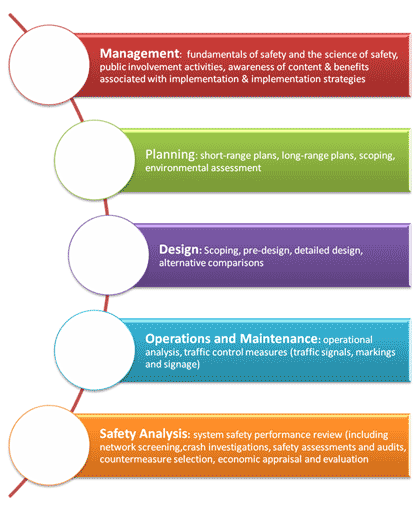
The training for the Management key focus group covers fundamental knowledge and familiarity necessary to support successful implementation of the HSM including transportation administration. The HSM training module content and sequence for each of the focus groups will need to address issues such as differences in current level of knowledge and skills related to the HSM.
A key consideration in training is to provide specific practical sessions that may be of value to each of the key focus groups. For example, in design, a practical session highlighting how the HSM can add value to the alternative comparison and evaluation process would be of particular benefit. For the safety analyst, demonstrating differences in priorities identified with the more advanced statistical approaches and the improvement of accuracy would be beneficial.
Ultimately, it is critical that those participating in training will be able to implement what they have learned in a meaningful way. It is foreseen that the recommended content for each of the key focus groups will also include particular focus on strategies for implementing and institutionalizing the HSM.
The next subsection provides the results of a chapter-by-chapter assessment of the HSM for each of these key topic groups and a more detailed discussion of an approach to the training of each of these groups.
An Approach to the Training of the Key Focus Groups
Exhibit 3 presents an example of an assessment of each HSM chapter and its applicability to each of the five key focus groups.
The remainder of this subsection provides a summary of each of the key focus groups and a modular approach to the training of each of these groups.
The sequencing of training topics for each of these focus groups does not represent the sequencing of chapters within the HSM. During the course of the development and piloting of the NCHRP 17-38 overview training, it became evident that the HSM chapter sequence does not offer an appropriate sequence for training. By sequencing the training as presented for each of the focus groups, participants are able to better integrate new concepts in the HSM with their existing background in safety. Where the science of safety in the HSM represents a change from the existing approaches and beliefs a particular focus group may hold, the sequencing offers opportunity early on to deal with these paradigm shifts that are necessary for successful implementation of advanced methods and approaches in the HSM. When reviewing the sequencing of topics, the reader can refer to section 4 where descriptions are provided for each of the different modules within the NCHRP 17-38 training materials.
| Applicable Chapters of HSM | Management | Planning | Design | Operations & Maintenance | Safety Analysis |
|---|---|---|---|---|---|
| Part A – Introduction, Human Factors, and Fundamentals | |||||
| 1 – Introduction & Overview | X | X | X | X | X |
| 2 – Human Factors | X | X | X | X | X |
| 3 – Fundamentals | X | X | X | X | X |
| Part B – Roadway Safety Management Process | |||||
| 4 – Network Screening | X | X | |||
| 5 – Diagnosis | X | X | X | ||
| 6 – Select Countermeasures | X | X | X | X | |
| 7 – Economic Appraisal | X | X | X | X | |
| 8 – Prioritize Projects | X | X | |||
| 9 – Safety Effectiveness Evaluation | X | X | |||
| Part C - Predictive Method | |||||
| 10 – Rural Two-Lane, Two-Way Roads | X | X | X | ||
| 11 – Rural Multilane Highways | X | X | X | ||
| 12 – Urban and Suburban Arterials | X | X | X | X | |
| Part D – Crash Modification Factors | |||||
| 13 – Roadway Segments | X | X | X | X | |
| 14 –Intersections | X | X | X | X | |
| 15 – Interchanges | X | X | X | X | |
| 16 – Special Facilities and Geometric Situations | X | X | X | X | |
| 17 – Road Networks | X | X | X | X | |
Management Focus Group Training Needs
The Management focus group represents professionals and management that are not intricately involved in the planning, design, and operations and maintenance activities (e.g., transportation administration and decision makers).
This group would benefit most from a general overview and reviewing the benefits of implementing the HSM, as seen in Exhibit 4.
Of utmost importance to this group is training that provides an Introduction and Overview to the HSM. The content of the FHWA Resource Center HSM Introduction & Overview webinar can serve the basic needs of this group. Training on Fundamentals would provide a better understanding of the science behind the HSM but is likely not as critical for this particular focus group.
EXHIBIT 4. Management Focus Group Training Needs

Planning Focus Group Training Needs
The Planning Focus Group includes those involved in the development of long- and short-range plans, corridor studies, environmental assessments, and alternatives assessment.
There are several opportunities for this focus group to apply the HSM to job activities including the applications from Parts B, C, and D. The training needs of this group may vary based on level of experience. Someone who is newer to transportation planning may not be intricately familiar with the roadway safety management process and may benefit from a training program that covers all of Parts B, C, and D. However, those that have been in transportation planning for a period of time and are more familiar with the roadway safety management process and traditional applications of the network screening process would benefit most from a training program focused on Parts C and D of the HSM and how these concepts tie into the network screening process.
For a training program designed for the planning group and the remaining focus groups, it is essential to provide a foundation for the training with a course covering an introduction and overview of the HSM, as well as fundamentals. As shown in Exhibit 5, the recommended logical training flow would include courses on Parts D and C followed by training on network screening (Chapter 4) to facilitate comprehension of the applications of the various performance measures for network screening. For those more familiar with the roadway safety management process, this might suffice for training needs. For those less familiar with the process, it would be ideal to include courses focused on human factors (Chapter 2), diagnosis (Chapter 5), countermeasure selection (Chapter 6), economic appraisal (Chapter 7, and project prioritization (Chapter 8).
EXHIBIT 5. Planning Focus Group Training Needs
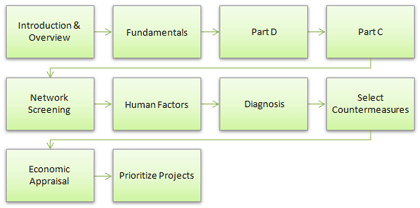
Design Focus Group Training Needs
The Design Focus Group includes those involved in project scoping, preliminary design, and final design, including alternative comparisons. This group will assess the safety performance of different design alternatives and variation in particular design parameters or roadway features.
It is critical that this group understands Parts C and D. This group should be able to assess the safety performance of various design alternatives using the Predictive Methods in Part C and to assess the safety impacts of changes to roadway features using Part C and Part D upon completion of the training.
Exhibit 6 presents the flow diagram for a typical training program for this focus group. The recommended flow starts with courses providing an introduction, overview and fundamentals. While this focus group will not typically be involved in diagnosing safety problems, a course on human factors will set a foundation for human factor-related considerations throughout the design process. Once a foundation has been set, the recommended training program should focus on Parts D and C. This focus group would also greatly benefit from the NHI course on the Interactive Highway Safety Design Model. The concepts in Part B are not as critical for this focus group, but a training course on selecting countermeasures and economic appraisal could be useful. Training on the topic of human factors is necessary to support design approaches and alternatives that reduces user error and reduces the outcomes of user error.
EXHIBIT 6. Design Focus Group Training Needs
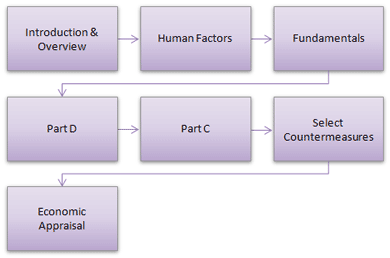
Operations and Maintenance Focus Group Training Needs
The Operations and Maintenance Focus Group includes those who conduct operational analysis and develop traffic control plans. It is most likely that this group will use the HSM to assess the impacts on safety of signal timing adjustments, lane modifications, and roadway mitigations.
This focus group will benefit most from a training program that focuses on Parts B and D of the HSM. Once again, this training program for this focus group should begin with an introduction and overview of the HSM, followed by the fundamentals, as shown in Exhibit 7. The training program should then include a course on Part D followed by Part C, human factors (Chapter 2) and the applicable concepts in Part B: including diagnosis (Chapter 5), countermeasure selection (Chapter 6), economic appraisal (Chapter 7), and safety effectiveness evaluation (Chapter 9). Inclusion of Part C in the training is essential to support safety quantification of the impact of changes to the existing network, performing benefit-cost analysis of alternative countermeasures, and conducting before-after studies using advanced methods.
EXHIBIT 7. Operations & Maintenance Focus Group Training Needs
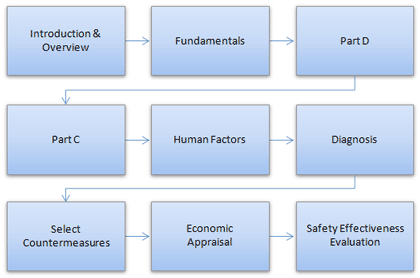
Safety Analysis Focus Group Training Needs
The Safety Analysis focus group includes individuals who are primarily responsible for safety. This may include those involved in system safety performance review, crash investigations, safety assessments and audits, and/or countermeasure selection.
This focus group should be familiar with the entire contents of the HSM. It is recommended that this focus group follow a training sequence very similar to those in the planning focus group, but that this training program also include a course on safety effectiveness evaluation, as shown in Exhibit 8. This group would benefit from courses on Parts D and C, followed by Part B of the HSM. The HSIP courses currently under development on Project Identification and Project Evaluation would be ideal to cover Part B of the HSM as described within the context of the HSIP.
The NCHRP 17-38 HSM Overview Training Modules can be tailored to address the training needs of target focus groups. This would allow for an intermediate depth of knowledge, followed by more in-depth (advanced) training course(s) to address the critical knowledge for each focus group.
EXHIBIT 8. Safety Analysis Focus Group Training Needs
